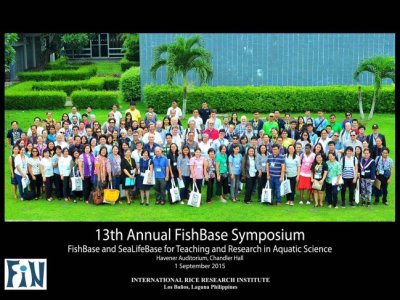 Between 300,000 and 700,000 users per month around the globe - how many know how the backstage of FishBase works and the incredibly diverse ways in which fellow-users take advantage of this gold mine of information on all fish in the world? The annual FishBase symposium is an opportunity to find out more and keep in touch with latest developments.
Between 300,000 and 700,000 users per month around the globe - how many know how the backstage of FishBase works and the incredibly diverse ways in which fellow-users take advantage of this gold mine of information on all fish in the world? The annual FishBase symposium is an opportunity to find out more and keep in touch with latest developments.
This year's 13th annual FishBase Symposium was fittingly convened in the Philippines, where it was originally conceived and the foundations laid some 25 years ago by Daniel Pauly and Rainer Froese.
The key organiser of this outstanding event was the FishBase Information and Research Group, FIN, based at the International Rice Research Institute (IRRI) in Los Baños.
The focal theme for celebrating the 25th anniversay of FishBase and the 10th anniversary of SeaLifeBase was using these public web resources for teaching and research.
The programme featured talks by several key members of the FishBase consortium and Filipino researchers and lecturers reporting their experiences in collaborating with FishBase and SeaLifeBase and the interesting use they make of the web archives. Kathleen K. Reyes, a research associate of FIN, served as master of ceremony introducing all speakers.
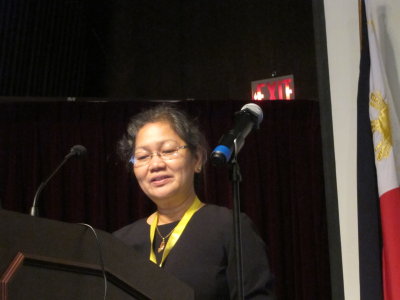 Dr. Mary Ann P. Bimbao, Executive Director of the FishBase Information and Research Group, FIN, and host opened the symposium. Naming guests of honour and all FishBase Consortium members, Dr. Bimbao explained that the FishBase symposium is an annual event of the consortium and conducted in tandem with its annual meeting.
Dr. Mary Ann P. Bimbao, Executive Director of the FishBase Information and Research Group, FIN, and host opened the symposium. Naming guests of honour and all FishBase Consortium members, Dr. Bimbao explained that the FishBase symposium is an annual event of the consortium and conducted in tandem with its annual meeting.
The venue rotates among members. While FIN is not a consortium member, they wanted to honour the organisation and its highly dedicated Filipino staff with academic displines in marine sciences, aquatic biology and information technology by convening the symposium here. FishBase and SeaLifeBase are handled institutionally by FIN.
The aim of the symposium was to provide deeper understanding of why and how FishBase and SeaLifeBase could be used more widely in the Philippines for teaching and research. Sixteen institutional - national and international - sponsors supported FIN's organisational efforts. The reward were about 175 registered participants from 45 institutions.
The week-long celebrations also entailed a book giving event for local libraries, a poster-exhibition with hands-on orientations for students and researchers about the aquatic biodiversity information systems, an art competition and a fisheries data workshop.
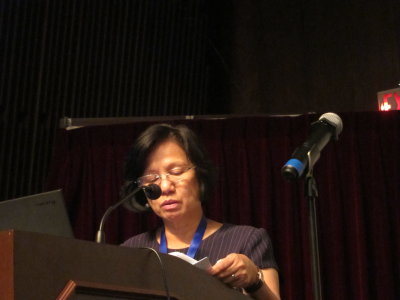 Next to take the floor for an institional welcome was Dr. Bruce Tolentino, Deputy Director General for Communication and Partnership of the International Rice Research Institute, Philippines. He spoke eloquently about the importance of rice research for food security around the world, particularly under conditions of global change. He evoked the traditional practice of keeping rice and fish in the same fields for increased overall yield as one of the reasons why rice and fish researchers should meet and interact more frequently.
Next to take the floor for an institional welcome was Dr. Bruce Tolentino, Deputy Director General for Communication and Partnership of the International Rice Research Institute, Philippines. He spoke eloquently about the importance of rice research for food security around the world, particularly under conditions of global change. He evoked the traditional practice of keeping rice and fish in the same fields for increased overall yield as one of the reasons why rice and fish researchers should meet and interact more frequently.
Assistant Director for Technical Services and Executive Director of the National Fisheries Research and Development Institute, Ms. Drusila Bayate delivered the welcome of Dr. Asis G. Perez, Director of the Philippine Bureau of Fisheries and Aquatic Resources (BFAR). She underlined the unwavering support of BFAR to FIN and the collaboration on developing and sustaining the global information system for support to conservation and management of aquatic biodiversity and ecosystems. Citing the joint development of fish rulers indicating the length at first maturity of local fish served to illustrate the long-standing collaboration.
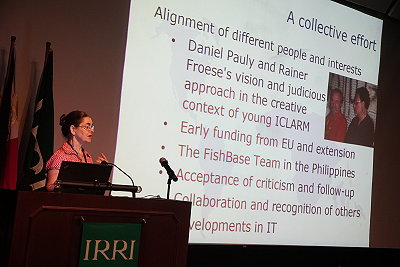
The European public investment into the early development phases was originally justified with support to better decision-making for fisheries management in developing countries particularly in Africa, the Caribbean and the Pacific. Her analysis of usage published in 2006 showed that the objective was over-achieved. Indeed, the advent of the internet at the end of the 1990s opened this fabulous resource up also to all kinds of other users. This was possible because early on it had been agreed to make access free and as easy as possible (no registration, no programming...).
The FishBase consortium of a growing number of national and international public institutions maintained this spirit in its daily practice. They were thus able to attract a very large international collaboration for FishBase and SeaLifeBase. Much recognition for this is also due to FIN, the invaluable backbone of keeping it all up and continuously developing. This productive constellation has translated into immense individual and societal benefits. Nobody had been able to anticipate in the beginning, 25 years ago.
F ishBase and SeaLifeBase have empowered and inspired many. They form the foundation of many lines of research, prominently e.g. the catch reconstructions of marine fisheries around the world through the Sea Around Us Project collaboration led by Daniel Pauly and Dirk Zeller. This helps to anchor our perceptions of human impact on the ocean to a more realistic framework compared to widespread shifting baseline syndrome or outright recklessness.
ishBase and SeaLifeBase have empowered and inspired many. They form the foundation of many lines of research, prominently e.g. the catch reconstructions of marine fisheries around the world through the Sea Around Us Project collaboration led by Daniel Pauly and Dirk Zeller. This helps to anchor our perceptions of human impact on the ocean to a more realistic framework compared to widespread shifting baseline syndrome or outright recklessness.
Such advances in the marine sciences can be connected to new knowledge and insights in education and other social sciences to take FishBase and SeaLifeBase to the next stage. The rise of social media and citizen science how offer fresh opportunities to shift humanity's prevailing extractive impulses towards more caring approaches which enable sustainable living and being on our Blue Planet. See slides here.
Dr. Daniel Pauly then held the long-awaited keynote address that cast light on some of the major scientific break-throughs enabled by FishBase and SeaLifeBase and what they mean.
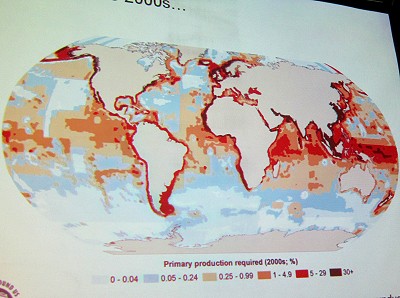 Among the major inspirations of FishBase has been the challenge to global catch statistics compiled by FAO on the basis of official declarations of its member countries. These are known not to be very accurate, be it rarer cases of significant overreporting as in the case of China for its domestic production (Watson and Pauly, 2000) or the more generalised case of under-reporting, particularly of small-scale fisheries. Illegal catches and discards at sea, which can be very high in some fisheries are also not represented in the official records.
Among the major inspirations of FishBase has been the challenge to global catch statistics compiled by FAO on the basis of official declarations of its member countries. These are known not to be very accurate, be it rarer cases of significant overreporting as in the case of China for its domestic production (Watson and Pauly, 2000) or the more generalised case of under-reporting, particularly of small-scale fisheries. Illegal catches and discards at sea, which can be very high in some fisheries are also not represented in the official records.
Careful reconstruction of true catches in 270 states and territories showed that official FAO statistics capture only about half of the global extractions. The reconstructions were carried out by the Sea Around Us Project with some 400 scientists collaborating scientists from around the world. FishBase and SeaLifeBase contributed distribution ranges, trophic and size information about fish and invertebrates.
New work on West African catches shows that about half of these are by foreign fleets between the 1970s and 2010. 10% of the catches are estimated to be outright illegal. The domestic catch is split approximately equally between industrial and artisanal fleets. The reconstructed catches do not tally well with FAO statistics, which miss about 25% of the total.
These major corrections to official numbers affect the overall interpretation of the situation quite significantly. Human impact is much higher as officially admitted. Translating this into primary production needed to sustain the current exptractions, intensive exploitation rates of all coastal ecosystems is reaching extents similar to heavily exploited land ecosystems in Europe, the North Pacific, SE Asia and West Africa. That conveys an additional sense of urgency to the need for rehabilitation of marine ecosystems to their former productivity and resilience.
 Rainer Froese, the “other father” of FishBase based at GEOMAR Kiel, Germany, focused his talk on how to make better use of the information systems content on life history traits of fish in different ecological niches and temperature ranges. He suggested using Bayesian inference to ultimately estimate growth and natural mortality parameters of all fish species. It would allow to chose the most relevant parameters for well-investigated species across their entire range, but also make inferences for little studied species or those where no data were available except from close relatives. The approach has already been successfully used for estimating length-weight relationships for species without such estimates in the scientific literature, confirmed by later empirical evidence.
Rainer Froese, the “other father” of FishBase based at GEOMAR Kiel, Germany, focused his talk on how to make better use of the information systems content on life history traits of fish in different ecological niches and temperature ranges. He suggested using Bayesian inference to ultimately estimate growth and natural mortality parameters of all fish species. It would allow to chose the most relevant parameters for well-investigated species across their entire range, but also make inferences for little studied species or those where no data were available except from close relatives. The approach has already been successfully used for estimating length-weight relationships for species without such estimates in the scientific literature, confirmed by later empirical evidence.
He wants to apply this approach in the next three years also to maturity and mortality aiming at the intrinsic rate of population increase (= resilience) for all species of fish.
Nicolas Bailly, currently Scientific Director of LifeBase Greece in Crete, advocated a mixed approach to maintaining and further developing biodiversity databases, part top down and part bottom up, in order to strike a useful balance between the need for easy structured analyses for on-purpose research and the desire to make data as widely available as possible for current and future use. It is hoped that such a mixed approach might minize costly parallel development of similar biodiversity databases by different research groups.
Jos Snoeks of the Royal Museum of Central Africa in Tervuren, Belgium, and his team presented the efforts to train so far 55 African colleagues in ichthyology over the years in their successful effort to constantly update information on African fish. A recently started collaboration with IUCN helps to bring the taxonomic backbones of FishBase and the IUCN database in line and facilitate Red List assessments.
Kostas I. Stergiou of the Institute of Marine Biological and Inland Water Resources in Greece elaborated on the most famous fish based on records in Google's Ngram. The title falls to the gold fish (Carassius auratus auratus) the most common aquarium fish, well ahead of the most popular marine species, sword fish (Xiphias gladius).
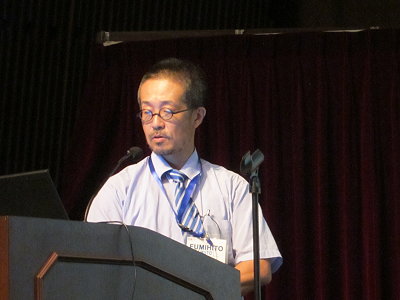 Markus Skyttner of the Swedish Museum of Natural History reported on database developments with RAquamaps for predicting distribution of marine fish based on open source software.
Markus Skyttner of the Swedish Museum of Natural History reported on database developments with RAquamaps for predicting distribution of marine fish based on open source software.
Fumihito Muto of the Laboratory of Fisheries Resources at Tokai University sketched out the efforts to build up a Japanese version of FishBase in collaboration with a team at Iwate University.
Cesar Luna of the University of the Philippines Open University in Los Baños presented preparations for a new online course on fish taxonomy, evolution, morphology, biodiversity, reproduction, physiology and role in exploited ecosystems. It is based on an online ichthyology course material developed by Pauly et al. (2009). The course will start in 2016 for about 145h of guided independent self-study.
Benjamin M. Vallejo jr of the University of the Philippines Dilliman, Quezon City, reported enthusiastically about his use of FishBase in his teaching biodiversity courses. He finds that the online databases enable much more efficient learning than earlier library resources. They also help reduce collecting specimens in the wild, especially of threatened species, which must be protected.
 Patrick Co of WWF Philippines gave another example of using FishBase for virtual training of staff and students at state universities and colleges as part of the Coral Triangle Support Partnership (CTSP) University Mentoring Programme (UMP) in 2013.
Patrick Co of WWF Philippines gave another example of using FishBase for virtual training of staff and students at state universities and colleges as part of the Coral Triangle Support Partnership (CTSP) University Mentoring Programme (UMP) in 2013.
Asuncion B de Guzman, an independent researcher and development worker from Misamis Oriental, reported on using FishBase e.g. for correcting misreporting of Bali sardine (Sardinella lemuru) as Sardinella longiceps and assessing climate change vulnerability of coastal fisheries in norther Mindanao. She also uses SeaLifeBase to identify and validate the taxonomy of marine invertebrates gathered by subsistence fisheries in Mindanao and Bohol.
Augustus Rex Montebon of Conservation International Philippines harked back at the collaboration with FIN on producing fish rulers for several regions in the Philippines to raise awareness about the need to spare juvenile fish of the most common species. He also outlined ongoing work on an initiative to extend marine protected areas in response to overfishing.
Mathieu Colléter of the Sea Around Us at the University of British Columbia introduced his work on developing a repository for Ecopath with Ecosim (EwE) models as a way to facilitate metaanalyses as a road to further understanding marine ecosystem. His enthusiasm about EcoBase was contagious and is expected to bring about more synergies and intensify collaboration between researchers modeling ecosystems and those working biodiversity databases like FishBase and SeaLifeBase.
 Christian Elloran of the ASEAN Centre for Biodiversity presented experience with sharing information on biodiversity among the 10 Member States of the Association of SE Asian Nations (ASEAN). Since 2010 they are collaborating with FishBase.
Christian Elloran of the ASEAN Centre for Biodiversity presented experience with sharing information on biodiversity among the 10 Member States of the Association of SE Asian Nations (ASEAN). Since 2010 they are collaborating with FishBase.
Maria Lourdes Deng Palomares, current Chair of the FishBase Consortium and SeaLifeBase Project Coordinator, spoke to the hope that the Philippines, where FishBase and SeaLifeBase were originally conceived would take the fullest advantage from these successful repositories of scientific knowledge for their own teaching, research and management needs.
She also provided the summary of the day-long symposium and thanked the many organisations, colleagues and helpers who had created this great opportunity to learn about latest advances in marine science and its use.
More photos were for some time visible on the FIN website in the photo gallery of speakers and the award ceremony for youth participating in the paint and photo competition for different age groups organised by FIN to mark the anniversaries.































